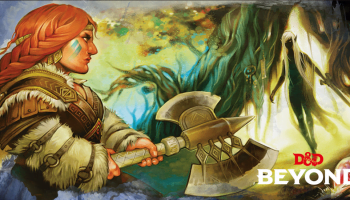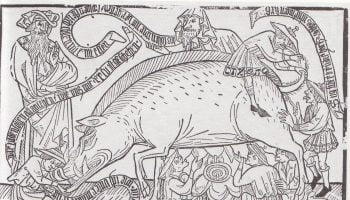This is part of The Public Medievalist’s continuing series on Race, Racism and the Middle Ages. You can find the entire series here.
This bizarre image is from a 1544 book called the Cosmographia, a catalogue of peoples of the earth. The Cosmographia itself, though slightly post-medieval, is based on the medieval pseudo-travelogue Mandeville’s Travels. Though it presents itself as a true account, modern readers know that Mandeville’s Travels is completely invented. But Mandeville’s book was quite influential in medieval times and for centuries afterward: Christopher Columbus and Sir Walter Raleigh are said to have consulted Mandeville before their colonial explorations. Mandeville’s messages about the earth’s different people—particularly the earth’s different races—thus may have played a role in the centuries of conquest, slavery, and discrimination that would follow the Middle Ages.
The races Mandeville says he encountered are rather unconventional. Take the Ethiopian “sciapod,” the man with the huge foot in the image above. His foot is large, according to Mandeville, so he can shield himself from the hot African sun. And standing to his left, hanging out between a Cyclops and a dog-headed man, is the “Indian” Blemmyae: a man with a face in his chest—because he has no head. Mandeville tells us his condition is a curse from God, possibly for cannibalism.
Clearly, Mandeville had distressing ideas about what foreign bodies looked like. Perhaps even more disturbing were his ideas about why they looked that way. Obviously, he never actually encountered the strange races he imagined, but like many medieval people, Mandeville believed that a body’s external appearance revealed a person’s internal qualities. The foreign bodies he imagined took shape based on this fantasy.
Medieval people believed that bodies were fraught with meaning, and not just foreign bodies. An external change in appearance could be evidence of an internal emotional or religious condition. If a knight lost his color, for instance, he was usually diagnosed with lovesickness. But there are less benign examples. Leprosy was sometimes considered a physical manifestation of sin devouring the body, which led to the social ostracizing and abuse of its victims.

Before we get ahead of ourselves and decide humanity abandoned this kind of ignorant thinking when we discovered that the earth revolved around the sun, consider the way a lot of modern science fiction imagines aliens. From Whitley Streiber’s Communion and Stargate’s Asgard to Men in Black and even the “alien” emoji, we expect people from outer space to have enormous heads and eyes, but no body hair. Ostensibly, their large heads represent their greater intelligence. Their lack of hair may connote their disconnection from what we consider to be our own lowly ‘animal’ natures and the great heights of civilization these aliens have obtained.
In other words, both now and in the Middle Ages, the body is not just a biological machine or a shell for a soul. Some people imagine that it functions as a prophetic tome, an external text we think we can “read” to determine a person’s internal characteristics. This notion that bodies can be interpreted to learn about geography, culture, illness, or sin form the foundation of the complicated medieval concept of race. And some of its most problematic features are still with us today.
Racism’s Childhood
Until recently, many scholars considered the Middle Ages innocent of racism. They claimed that the origins of modern-day racism lay in the Renaissance, when Europe launched the transatlantic slave trade. Any comparison between medieval and modern ideas about race risked charges of “presentism”: superimposing contemporary values inappropriately onto the past. Yet although medieval ideas about race, bodies, and color differ from our own, difference is not the same thing as disconnection. Rather, as the late Italian scholar Umberto Eco has argued, “looking at the Middle Ages means looking at our infancy, in the same way that a doctor, to understand our present state of health, asks us about our childhood.” And as it turns out, looking at the Middle Ages can teach us a lot about both our deeply ingrained ideas about bodies and the racism that we are still confronted with today.
An apt example lies in one of the most perplexing moments in the medieval understanding of bodies. The Middle English poem The King of Tars, (which Rachel Moss has recently written about very poignantly), features a Muslim Sultan who converts to Christianity. At the moment of his conversion, the angels don’t sing. There’s no applause. Lightening doesn’t strike a mosque or anything. Instead, something even more bizarre happens: when he converts, the sultan turns from black to white.
Worse yet is the poem’s depiction of an interracial child. Before his conversion, the Sultan has a son with his Christian wife. But that child is born a shapeless lump of flesh with no bones. As soon as the child is baptized as a Christian, however, it instantly transforms into an beautiful, healthy infant. Apparently some white medieval poets, like some contemporary politicians, had issues with “somebody else’s babies.”
Mapping Race
So what does the sciapod pictured above—the original Bigfoot, so to speak—have to do with the color-coded conversion of the Sultan and his child? The answer is complicated. When we look for the historical roots of complex ideas, thinking in linear terms can be inexact, at best. Instead, I like to think of historical concepts as a web. If you begin to trace one of the strands, you’ll often find that it’s inextricable from a veritable tangle of other strands.
For instance, one foundation of the medieval conception of race is “geographical determinism,” an idea that Paul and I have discussed in earlier posts. Geographical determinism is the theory that different environmental conditions—like proximity to the sun, access to water, and weather—create different human bodies and minds. This is the same convenient theory Julius Caesar employed to argue that Rome had the perfect conditions for human flourishing. The ancient Roman claim to environmental perfection was obviously not ideologically neutral: it led to a skewed view that saw that the rest of the world as somehow flawed.
Consider classical descriptions of Ethiopians. Ancient Greeks and Romans used the term “Ethiopian” to incorrectly conflate the residents of sub-Egyptian Africa. The word comes from the Greek Aethiops, which may have meant “sunburnt,” “fiery-looking,” or more literally, “burnt face.” The geographically-based designation “Ethiopian,” then, carries an implication of African Otherness, because of its companion assumption that the “unburnt” face is, presumably, just a face.
But while we might find a thread that leads to anti-African discrimination in some ancient etymologies, we cannot yet explain the hierarchy of whiteness that feeds contemporary racism. After all, the ancients themselves were darker than the whiter northern Europeans, whom the Romans considered strong and spirited, but not particularly bright. Instead, we have to trace this thread forward in time, and further north.
Medieval clerics, who often relied upon Roman texts, adopted their tendency to paint all of Africa with the broad Ethiopian brush. Their geographical determinism was also equally biased, just in a more northerly direction. Bartholomeus Anglicus, a thirteenth-century Franciscan monk, posited that the men of Africa were “burnt” by their proximity to sun. Bartholomeus argued that this gave them dark skin and curly hair, but because Bartholomeus also thought that courage could leak out of a man’s pores when he sweat, he claimed that Africans would be “cowards.” By contrast, men of the north (like Bartholomaeus himself, by eye-rollingly happy coincidence) were lucky enough to live in cold weather that “stoppeth the pores” and kept the people “bolde and hardy.” Albertus Magnus, his thirteenth-century contemporary, argued that Indians were bound to be good at magic and mathematics because a little heat could make a person smarter—but he declared that Ethiopians would be incapable of such things because they are exposed to too much heat.
At this point, it’s becoming harder and harder to distinguish geographical determinism from “ordinary” racism. Still, there is one thing Albertus believed that we do not: over the course of generations, he argued, people with black skin who were relocated to a cold climate would eventually turn white. To medieval Europeans, as Paul has pointed out, skin color was a changeable trait, not a permanent marker. And so we have another ingredient in our Sultanic conversion stew—that in the medieval mind, skin color can change with the weather.
Still, medieval climate change cannot fully explain the deeply problematic portrayal of the Sultan and his son in King of Tars. First of all, when the Sultan turns white, he’s still on his home turf. Second of all, his conversion is instantaneous, miraculous. We must consider, then, another crucial ingredient of his conversion, which is that the poet thought the Sultan’s formerly black body might be caused by his Muslim faith.
Seeing the Light?
Unraveling this thread gets us closer to the roots of the dichotomy between blackness and whiteness. Taken literally, the dichotomy is very strange: what made white people decide that they were white, as opposed to, say, beige? The privileging of whiteness, as scholars who dare to delve into medieval prejudice have discovered, may be the result of theological hierarchy. The color white was often used as a metaphor for spiritual purity; by the same token, some medieval writers used the color black to symbolize spiritual darkness.
Writers like the twelfth-century poet Chrétien de Troyes use blackness as a symbol of demonic nature: Chrétien’s Percival features a magical maiden who rides up on a mule, bearing a fierce-looking whip, who curses the hero. The narrator tells us, “You’ve never seen iron as black as her neck and hands.” This damsel’s exaggerated color is meant to imply her demonic origins: the narrator goes on to compare her to creatures who live in the bowels of hell. Likewise, when his hero Yvain rescues a group of ladies who are being held prisoner and forced to sew clothing continuously, their captors are described as the sons of a demon who are “black and hideous.”
Whiteness, on the other hand, is used to connote beauty or spiritual purity. Romance heroines such as Chrétien’s Enide and Fenice are described as “fairer and whiter than the Lily-flower” with bosoms “whiter than the new-fallen snow.” (This depiction also marks class distinction, which I will address below.) And as Paul notes, in the German romance Parzival, Fierefiz’s mother demonstrates her devotion to her black-and-white child’s Christian father by constantly kissing his white spots.
Some believe that these imagined connections between skin color and faith began during the Crusades. The Northern European crusaders found that the Jews and Muslims they encountered in the south had darker skin, and thus, they may have begun to associate this visible difference with a “stain” on their enemies’ souls. As a result, geographical determinism became inextricably entangled with religious thought.
White Gold
There is a final thread we need to consider, and this is the way medieval Europeans thought about class. Nobility was considered a God-given gift that gave aristocrats the right to rule. In medieval romance, class, like ethnicity and faith, can also be read on the body. Darker skin was sometimes considered a symbol of a lower class station, partly because of the hierarchy of whiteness, and partly for more practical reasons: nobles did not have to labor outdoors. Thus the heroine of the thirteenth-century romance Silence, a noblewoman masquerading as both a minstrel and a man, must stain her glistening white skin with dye so that she will not reveal herself as royalty.
So now we have a fuller picture of what on earth the author of The King of Tars was thinking when he transformed his Sultan from black to white. But it isn’t a pretty picture at all. The Sultan’s white skin is a marker of his internal ‘purification.’ This medieval poet believed that a person’s faith in the Christian God could help him transcend “limitations” of biology or birth. At the same time, conversion is also the force that colonizes both his black body and the Islamic world, erasing faith and their culture. The Sultan’s body becomes metaphorical ground for the pre-colonial fantasies of northern Europe.
Leaving Infancy Behind
Despite the fact that medieval ideas about race and bodies are not the same as modern ones, some of our worst stereotypes about the meaning of bodies and skin color began to take shape in the medieval past. And in the Renaissance, this confluence of ideas about race, geography, and faith led to the horrifying conclusion that the children of Africa carried the “curse of Ham” and were therefore destined to be enslaved. Even in today’s supposedly ‘enlightened’ scientific age we persist in looking for physical evidence of the condition of someone’s soul and of their supposedly “natural” capabilities and inclinations. As advances in genetic research lead to casual metaphors about who does or doesn’t have democracy “in their DNA,” we must take care not to return to turning bodies into texts that we think we can read.
The Public Medievalist does not pay to promote these articles, so we would love it if you shared this with your history-loving friends! Click to share with your friends on Facebook, or on Twitter.








I think it is more straightforward to interpret the transformation of King of Tars as a reference to Psalm 51:7: “Purify me with hyssop, and I shall be clean; Wash me, and I shall be whiter than snow” Given the many Biblical associations between the color white and redemption, I think the King’s “whitening” after baptism is metaphor for his redemption.